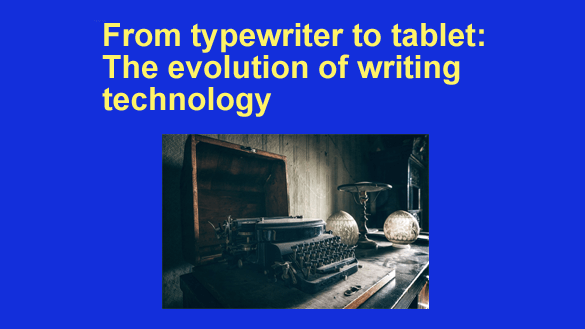 The first paper was created from papyrus in Ancient Egypt, and the rest, as they say, is history. Writers come in many shapes and forms; some write formal government press releases, while others pen your favorite novel.
The first paper was created from papyrus in Ancient Egypt, and the rest, as they say, is history. Writers come in many shapes and forms; some write formal government press releases, while others pen your favorite novel.
Every writer’s process looks different, and technology has come a long way to accommodate every genre and technique. In recent years, with the evolution of e-books and self-publishing, writing technology has grown more than ever – even writers can’t keep up.
Keyboards
Keyboards have become much flatter over time; when writing through tablets, phones, or touch screens, keyboards are no longer represented as physical buttons, allowing for more portable and accessible writing. Many writers prefer the touch of a physical keyboard, however.
Mechanical keyboards have been reintroduced into traditional computer spaces to allow writers more accurate typing options. Keyboards can also be detached, rotated, and battery-operated for the most comfortable writing setup. Key sizes can also vary to accommodate comfortable finger spacing.
Word Processing
The earliest word-processing devices were invented in the 1700s and predated the famous typewriter as we know it. Word processors refer to software that can help create, write, edit, and print documents from the computer.
Word processing software has existed since the 1970s, but modern word processing can do much more. Editing tools check for grammar, spelling, sentence structure, and tone. AI extensions suggest alternative phrasing, better titles, and built-in dictionary and thesaurus information. Documents can be saved on the cloud, eliminating the need for local storage space or manual document backup—documents can be accessed through any device with access to the account’s cloud. Writing is a lot more accessible today!
Book Formatting
Traditionally, authors would handwrite or use a typewriter to create a manuscript and submit it to a publisher or agent for editing and professional formatting. While this pipeline is still efficient and functional today, many authors publish their own works instead of those of traditional publishers.
The best book writing software allows you to write, edit, and format your writing without hiring anyone. These platforms check the writing’s spelling and grammar for errors and allow you to change a manuscript’s layout to fit a variety of formats, like e-books or large print.
Editing Technology
Software like Grammarly actively reads a writer’s typed text and suggests spelling and grammar corrections. While spell-checking has been a feature of word-processing software for decades, these tools are more capable than ever.
Word processors like Google Docs allow multiple editors and collaborators to make real-time suggestions and edit documents. Spell-checkers do far more than correct errors; they can suggest better phrasing, tones, and styles according to the writer’s preference.
Digital Portfolios
Before technology advanced, a writer looking to get hired had to carry manuscripts or physical documents to showcase their work to potential clients. Now, modern writers can upload or link their work to a digital profile. With a simple link, recruiters and clients can see a writer’s best works on one page. Digital technology, like online writing portfolios, makes it easier for writers to display their work and get hired.
AI Writing Tools
Artificial intelligence (AI) has been controversial among the creative career community. Some view artificial intelligence tools as ‘plagiarism’ or ‘uncreative.’ Others view AI tools as a sidekick to a writer.
Regardless of opinion, AI has changed the writing world for good. AI programs and tools can allow writers to brainstorm writing ideas, titles, headlines, outlines, and more. AI can serve as a way to boost inspiration or springboard writing ideas. Writers can finish their work faster and leave the planning and outlining to chatbots or AI tools.
Tablets and Smartphones
You don’t need a giant bulky typewriter, writing desk, or computer to write any longer. Writers can use minuscule screens and keyboards to write, edit, and format their work. Tablets can be attached to small keyboards to make writing easier but more portable. Writers can even write on smartphones and still have access to digital cloud storage. Portable writing options allow writers to travel or work from home easier than ever.
Social Media
Social media allows people to connect with millions with the click of a button. It has provided an excellent way for many brands and creators to advertise their content, including writers. Writers can promote their skills and work to audiences of millions using various social media platforms. Writers no longer rely on traditional publishing companies to spread the word about their new novels or editorials.
Digital Marketing
Social media remains only a part of the digital marketing world, which also includes search engines, email newsletters, websites, online ad space, and social media. No brand or writer can see success without utilizing at least one digital marketing strategy or tool.
Previously, authors and writers had to rely on newspaper companies, magazine publishers, and book publishers to promote their work. In-person advertising was limited by location and audience reach. With digital marketing, a book or article can reach an unlimited audience.
E-Books
Traditional paperback novels have competition due to the development and advancement of e-readers and reading applications. While physical books are still popular and printed, authors must release books in not just print and audiobook format but also formatted for e-readers. This may seem like another hurdle for authors, but this new technology allows their writing to reach more audiences.
